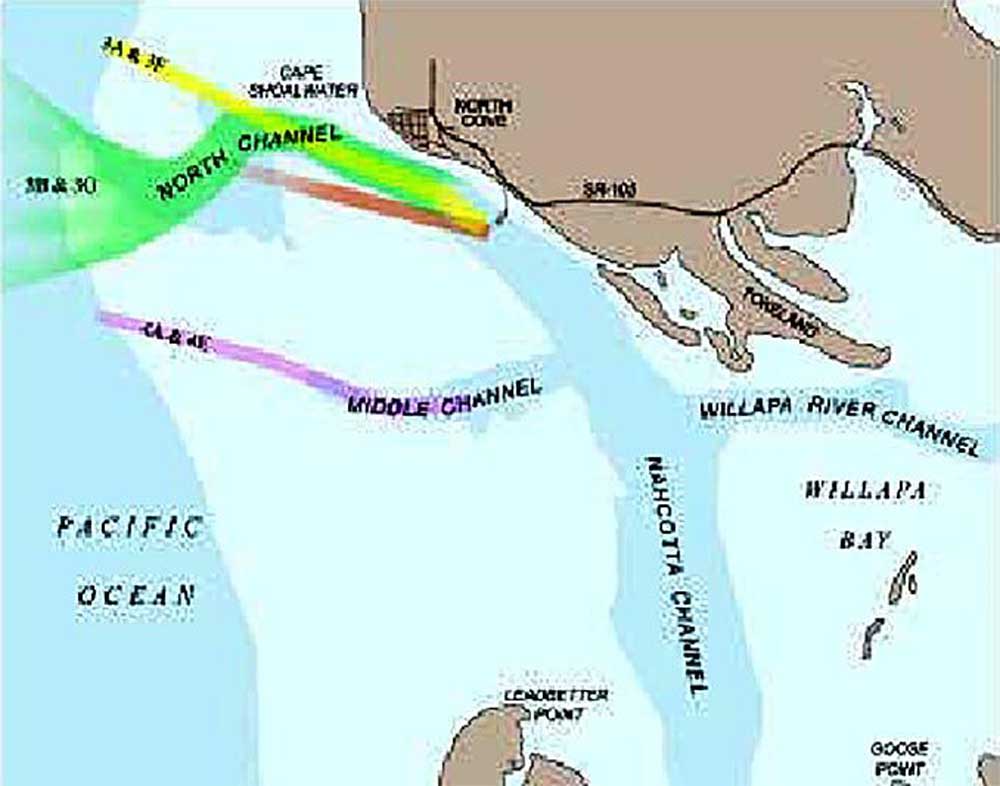Feds award $10M to combat Willapa beach erosion
Published 3:41 pm Monday, December 12, 2022

- Erosion has chewed away the north side of Willapa Bay’s mouth for generations, threatening State Route 105.
WASHINGTON, D.C. — Coastal erosion has officially been put on notice in Pacific County.
Trending
Last week, Sen. Maria Cantwell announced that the Washington State Department of Transportation was awarded a nearly $10 million federal grant to help prevent beach erosion at Graveyard Spit, located at Willapa Bay’s northern entrance. The project’s aim is to protect critical roads for residents of the Shoalwater Bay Indian Reservation and Tokeland, as well as preserve crucial habitat for endangered birds.
The funding for the project comes via the National Coastal Resilience Fund, which is managed by the National Fish and Wildlife Foundation (NFWF) and the National Oceanic and Atmospheric Administration (NOAA). The program, which is partly funded by the Bipartisan Infrastructure Law that was passed and signed into law in 2021, invests in restoring or expanding natural coastal features that protect people, fish and wildlife from hazards like storms and sea level rise.
WSDOT, which is providing nearly $800,000 in matching funds, will oversee construction of naturally sloped cobble berms at the project site that absorb the energy from waves and reduce beach erosion. The bay’s north entrance, which has long dealt with erosion, is classified as a high-energy coast, as large storms create crashing waves that have torn away sections of the beach — which has aptly been nicknamed “Washaway Beach.”
Trending
A second grant from the National Coastal Resilience Fund was also announced last week, as $940,000 was awarded to the Pacific Conservation District to complete a study of how development and sea level rise could affect the Willapa River and the local shellfish industry, as well as flood risks to Raymond and South Bend. The district is providing $172,500 in matching funds for the study.
“Communities around Willapa Bay have stepped up to save their shorelines, pioneering coastal erosion solutions like cobble berms,” Cantwell said in a Dec. 6 statement. “Matching community know-how with targeted grant funds is the smart way to face the climate crisis. These two grants help the residents of Pacific County take needed action now, while planning for future climate impacts.”
Beach erosion could eventually destroy parts of State Route 105 between Raymond and Westport, which is the only way to leave north for tribal and Tokeland residents. The endangered western snowy plover and streaked horned lark are both threatened by the shrinking coastal habitat, and a salt marsh located directly behind the beach is also being threatened.
Collaborative work
Chelsey Martin, a principal multi-modal planner with WSDOT, said the cobble berm will be approximately 4,000 feet long and mimic naturally occurring beaches in the area. More than 130 logs and root wads will be incorporated to dissipate both wave and wind energy.
“I’ve been working in this area for over 10 years, and I’ve seen the rapid shoreline erosion firsthand,” Martin said during an event following the funding announcement. “I know this means a lot to a lot of people.”
In all, the project will protect 65 acres of existing critical habitat and restore 20 acres of upland dune habitat and wetland marshes.
‘I’ve been working in this area for over 10 years, and I’ve seen the rapid shoreline erosion firsthand. I know this means a lot to a lot of people.’
Chelsey Martin
Principal multi-modal planner with WSDOT
Martin credited a seven-year process between multiple stakeholders to get the funding for the project across the finish line, including the Shoalwater Bay Tribe, NFWF, Washington State Department of Ecology, U.S. Army Corps of Engineers and WSDOT. She also highlighted the Willapa Erosion Control Action Now (WECAN) group, which WSDOT was able to partner with to conduct community outreach and engagement.
“Just going the extra mile for inclusion in small, coastal communities out here has been really great,” Martin said, adding this is the first grant of its kind that WSDOT has received.
“We’re used to doing large-scale projects and building infrastructure projects, but this is kind of outside of the box for us, which is really exciting and it’s just being proactive and implementing innovative solutions to save the roadway out here from coastal erosion,” she said, noting that emergency services and evacuation routes are served by State Route 105. “There’s no time like the present to get this going.”
This will not be the first large-scale project intended to protect the highway from erosion.
According to a 2005 report prepared for WSDOT, “The SR 105 Emergency Stabilization project began in the summer of 1997 to protect the North Cove area … from imminent destruction due to shore erosion …. Construction began in the early summer of 1998 and it was complete by September of that same year. Monitoring continued through the year 2001 and a final project report suggested that the combination of dikes and groins, coupled with beach nourishment, was successful.”









